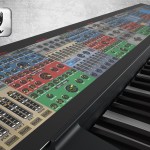 We posted a fantasy version of our MIDI Designer XW layout on the MatrixSynth lounge the other day (link to Facebook post | link to repost on the blog).
We posted a fantasy version of our MIDI Designer XW layout on the MatrixSynth lounge the other day (link to Facebook post | link to repost on the blog).
IPAD ONLY: SO SAD!
One potential user from the Netherlands wrote, “Why always iPad only. So sad” and then, later, “I simply like multiplatform. So programmers not forcing people to use a specific device/brand. There are a lot tools which are able to output ‘any’ OS.”
WHY NOT JUST MAKE IT MULTIPLATFORM?
Here’s how you imagine the development process:

SOME HISTORY
MIDI Designer development started in 2010, about two months before the first Android tablet was released (the Samsung Galaxy). It was a sunny Summer day, and I remember taking my mountain bike to Best Buy in New Jersey where I picked up my first iPad 1.
MIDI Designer was originally written in Java (cross-platform) and called “VirtualThang” (see this article which shows images of VirtualThang in Java on OSX). The movement to iPad was gradual and development was slow as I learned Objective-C to make MIDI Designer for iPad. There were no other tabs at this time, and serious cross-platform frameworks like Titanium Appcelerator didn’t come to focus on mobile until 2012!
I was using early versions of MIDI Designer in my personal drum rig by February 2011. My brother, Mike Rosenstark, a.k.a. User #1, didn’t begin to take MD seriously until about September of 2011. That’s when he suggested I coordinate the initial launch for NAMM 2012.
CROSS-PLATFORM AT NAMM 2012?
User #1 and I headed out to NAMM 2012 expecting people to object to MIDI Designer on three grounds:
- MIDI Designer talks MIDI only, and doesn’t use OSC
- MIDI Designer doesn’t do “automap” — it’s a traditional MIDI controller
- MIDI Designer isn’t cross-platform
OSC vs. MIDI—On the first point, it turns out that adoption rates of OSC are not what we imagined. For smaller companies, it’s hard to find the development time and spare the cost to implement OSC. For larger companies, having hundreds of products to add OSC to is a huge cost as well. As we learned at the 30th Year Anniversary of MIDI, and continue to see every year at NAMM, <opinion>MIDI will not be supplanted by OSC any time soon.</opinion>
No Automap?!—Automap and related concepts are huge in the MIDI world. Our competitors at Touchable, LiveControl 2 (requires Lemur) and many other players use concepts that we refer to as “automap”. Automap is awesome and they seem to be doing quite well. However, there’s still a huge market for a “generic” (or “modular”) MIDI controller platform like MD, both for custom rigs and for creating “editors” for MIDI-enabled hardware and software.
No Android?!—We were shocked see ONLY iPads at NAMM 2012, and again in 2013. This year (2014), there were some Android Tablets, but excluding those that were integrated into a device, they were few and far between. Professional music manufacturers were still focusing on iOS. This will change over time, of course, but in 2014, iOS still dominates for Pro Music applications.
So what!? Make me a version for Android, now!

This Doesn’t Really Exist
MIDI Designer is written 100% in Objective-C, which means that it’s written exclusively for Apple devices. For this to change we would need to rewrite MIDI Designer, essentially from scratch, either:
- In a cross-platform language like C++, using a cross-platform toolkit
- For a cross-platform framework, like Titanium
- Just make an Android version! How hard is this!?
None of these options are easy to do, and all would require a lot of development time. There are some technical difficulties to consider, relating to UI API differences, CoreMIDI/rtpMIDI availability on other platforms, and screen sizes on non-iOS devices (there are four general screen sizes for Android, and many more real sizes).
WILL WE RELEASE AN ANDROID/WINDOWS VERSION? Yes! We are confident that one or more of these three options is viable, and we’re currently exploring how best to translate the experience of MIDI Designer to other platforms. In the meantime, if you want MIDI Designer, an iPad 1 costs $99 on eBay. That’s cheaper than ANY Android tablet on the market. So there’s that…
For now, our main focus is on adding features to MIDI Designer for iOS. We’re expanding the platform that our users love and have dedicated hundreds of thousands of hours to. Will MIDI Designer be multi-platform in the future? YES!

